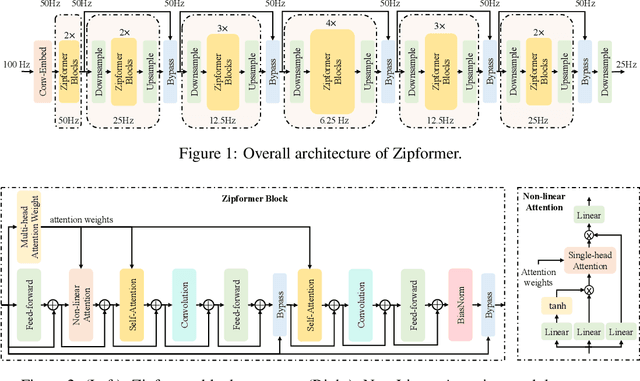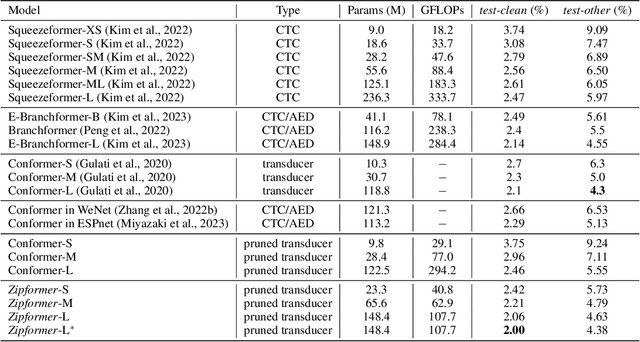Wei Kang
Controlling Language Difficulty in Dialogues with Linguistic Features
Sep 18, 2025Abstract:Large language models (LLMs) have emerged as powerful tools for supporting second language acquisition, particularly in simulating interactive dialogues for speaking practice. However, adapting the language difficulty of LLM-generated responses to match learners' proficiency levels remains a challenge. This work addresses this issue by proposing a framework for controlling language proficiency in educational dialogue systems. Our approach leverages three categories of linguistic features, readability features (e.g., Flesch-Kincaid Grade Level), syntactic features (e.g., syntactic tree depth), and lexical features (e.g., simple word ratio), to quantify and regulate text complexity. We demonstrate that training LLMs on linguistically annotated dialogue data enables precise modulation of language proficiency, outperforming prompt-based methods in both flexibility and stability. To evaluate this, we introduce Dilaprix, a novel metric integrating the aforementioned features, which shows strong correlation with expert judgments of language difficulty. Empirical results reveal that our approach achieves superior controllability of language proficiency while maintaining high dialogue quality.
HiPreNets: High-Precision Neural Networks through Progressive Training
Jun 18, 2025Abstract:Deep neural networks are powerful tools for solving nonlinear problems in science and engineering, but training highly accurate models becomes challenging as problem complexity increases. Non-convex optimization and numerous hyperparameters to tune make performance improvement difficult, and traditional approaches often prioritize minimizing mean squared error (MSE) while overlooking $L^{\infty}$ error, which is the critical focus in many applications. To address these challenges, we present a progressive framework for training and tuning high-precision neural networks (HiPreNets). Our approach refines a previously explored staged training technique for neural networks that improves an existing fully connected neural network by sequentially learning its prediction residuals using additional networks, leading to improved overall accuracy. We discuss how to take advantage of the structure of the residuals to guide the choice of loss function, number of parameters to use, and ways to introduce adaptive data sampling techniques. We validate our framework's effectiveness through several benchmark problems.
ZipVoice: Fast and High-Quality Zero-Shot Text-to-Speech with Flow Matching
Jun 16, 2025Abstract:Existing large-scale zero-shot text-to-speech (TTS) models deliver high speech quality but suffer from slow inference speeds due to massive parameters. To address this issue, this paper introduces ZipVoice, a high-quality flow-matching-based zero-shot TTS model with a compact model size and fast inference speed. Key designs include: 1) a Zipformer-based flow-matching decoder to maintain adequate modeling capabilities under constrained size; 2) Average upsampling-based initial speech-text alignment and Zipformer-based text encoder to improve speech intelligibility; 3) A flow distillation method to reduce sampling steps and eliminate the inference overhead associated with classifier-free guidance. Experiments on 100k hours multilingual datasets show that ZipVoice matches state-of-the-art models in speech quality, while being 3 times smaller and up to 30 times faster than a DiT-based flow-matching baseline. Codes, model checkpoints and demo samples are publicly available.
k2SSL: A Faster and Better Framework for Self-Supervised Speech Representation Learning
Nov 26, 2024Abstract:Self-supervised learning (SSL) has achieved great success in speech-related tasks, driven by advancements in speech encoder architectures and the expansion of datasets. While Transformer and Conformer architectures have dominated SSL backbones, encoders like Zipformer, which excel in automatic speech recognition (ASR), remain unexplored in SSL. Concurrently, inefficiencies in data processing within existing SSL training frameworks, such as fairseq, pose challenges in managing the growing volumes of training data. To address these issues, we propose k2SSL, an open-source framework that offers faster, more memory-efficient, and better-performing self-supervised speech representation learning, with a focus on downstream ASR tasks. The optimized HuBERT and proposed Zipformer-based SSL systems exhibit substantial reductions in both training time and memory usage during SSL training. Experiments on LibriSpeech and Libri-Light demonstrate that Zipformer-based SSL systems significantly outperform comparable HuBERT and WavLM systems, achieving a relative WER reduction on dev-other/test-other of up to 34.8%/32.4% compared to HuBERT Base after supervised fine-tuning, along with a 3.5x pre-training speedup in total GPU hours.
CR-CTC: Consistency regularization on CTC for improved speech recognition
Oct 07, 2024



Abstract:Connectionist Temporal Classification (CTC) is a widely used method for automatic speech recognition (ASR), renowned for its simplicity and computational efficiency. However, it often falls short in recognition performance compared to transducer or systems combining CTC and attention-based encoder-decoder (CTC/AED). In this work, we propose the Consistency-Regularized CTC (CR-CTC), which enforces consistency between two CTC distributions obtained from different augmented views of the input speech mel-spectrogram. We provide in-depth insights into its essential behaviors from three perspectives: 1) it conducts self-distillation between random pairs of sub-models that process different augmented views; 2) it learns contextual representation through masked prediction for positions within time-masked regions, especially when we increase the amount of time masking; 3) it suppresses the extremely peaky CTC distributions, thereby reducing overfitting and improving the generalization ability. Extensive experiments on LibriSpeech, Aishell-1, and GigaSpeech datasets demonstrate the effectiveness of our CR-CTC, which achieves performance comparable to, or even slightly better than, that of transducer and CTC/AED.
LibriheavyMix: A 20,000-Hour Dataset for Single-Channel Reverberant Multi-Talker Speech Separation, ASR and Speaker Diarization
Sep 01, 2024



Abstract:The evolving speech processing landscape is increasingly focused on complex scenarios like meetings or cocktail parties with multiple simultaneous speakers and far-field conditions. Existing methodologies for addressing these challenges fall into two categories: multi-channel and single-channel solutions. Single-channel approaches, notable for their generality and convenience, do not require specific information about microphone arrays. This paper presents a large-scale far-field overlapping speech dataset, crafted to advance research in speech separation, recognition, and speaker diarization. This dataset is a critical resource for decoding ``Who said What and When'' in multi-talker, reverberant environments, a daunting challenge in the field. Additionally, we introduce a pipeline system encompassing speech separation, recognition, and diarization as a foundational benchmark. Evaluations on the WHAMR! dataset validate the broad applicability of the proposed data.
Rolling bearing fault diagnosis method based on generative adversarial enhanced multi-scale convolutional neural network model
Mar 21, 2024


Abstract:In order to solve the problem that current convolutional neural networks can not capture the correlation features between the time domain signals of rolling bearings effectively, and the model accuracy is limited by the number and quality of samples, a rolling bearing fault diagnosis method based on generative adversarial enhanced multi-scale convolutional neural network model is proposed. Firstly, Gram angular field coding technique is used to encode the time domain signal of the rolling bearing and generate the feature map to retain the complete information of the vibration signal. Then, the re-sulting data is divided into a training set, a validation set, and a test set. Among them, the training set is input into the gradient penalty Wasserstein distance generation adversarial network to complete the training, and a new sample with similar features to the training sample is obtained, and then the original training set is expanded. Next, multi-scale convolution is used to extract the fault features of the extended training set, and the feature graph is normalized by example to overcome the influence of the difference in feature distribution. Finally, the attention mechanism is applied to the adaptive weighting of normalized features and the extraction of deep features, and the fault diagnosis is completed by the softmax classifier. Compared with ResNet method, the experimental results show that the proposed method has better generalization performance and anti-noise performance.
Zipformer: A faster and better encoder for automatic speech recognition
Oct 17, 2023



Abstract:The Conformer has become the most popular encoder model for automatic speech recognition (ASR). It adds convolution modules to a transformer to learn both local and global dependencies. In this work we describe a faster, more memory-efficient, and better-performing transformer, called Zipformer. Modeling changes include: 1) a U-Net-like encoder structure where middle stacks operate at lower frame rates; 2) reorganized block structure with more modules, within which we re-use attention weights for efficiency; 3) a modified form of LayerNorm called BiasNorm allows us to retain some length information; 4) new activation functions SwooshR and SwooshL work better than Swish. We also propose a new optimizer, called ScaledAdam, which scales the update by each tensor's current scale to keep the relative change about the same, and also explictly learns the parameter scale. It achieves faster convergence and better performance than Adam. Extensive experiments on LibriSpeech, Aishell-1, and WenetSpeech datasets demonstrate the effectiveness of our proposed Zipformer over other state-of-the-art ASR models. Our code is publicly available at https://github.com/k2-fsa/icefall.
PromptASR for contextualized ASR with controllable style
Sep 20, 2023Abstract:Prompts are crucial to large language models as they provide context information such as topic or logical relationships. Inspired by this, we propose PromptASR, a framework that integrates prompts in end-to-end automatic speech recognition (E2E ASR) systems to achieve contextualized ASR with controllable style of transcriptions. Specifically, a dedicated text encoder encodes the text prompts and the encodings are injected into the speech encoder by cross-attending the features from two modalities. When using the ground truth text from preceding utterances as content prompt, the proposed system achieves 21.9% and 6.8% relative word error rate reductions on a book reading dataset and an in-house dataset compared to a baseline ASR system. The system can also take word-level biasing lists as prompt to improve recognition accuracy on rare words. An additional style prompt can be given to the text encoder and guide the ASR system to output different styles of transcriptions. The code is available at icefall.
Libriheavy: a 50,000 hours ASR corpus with punctuation casing and context
Sep 15, 2023



Abstract:In this paper, we introduce Libriheavy, a large-scale ASR corpus consisting of 50,000 hours of read English speech derived from LibriVox. To the best of our knowledge, Libriheavy is the largest freely-available corpus of speech with supervisions. Different from other open-sourced datasets that only provide normalized transcriptions, Libriheavy contains richer information such as punctuation, casing and text context, which brings more flexibility for system building. Specifically, we propose a general and efficient pipeline to locate, align and segment the audios in previously published Librilight to its corresponding texts. The same as Librilight, Libriheavy also has three training subsets small, medium, large of the sizes 500h, 5000h, 50000h respectively. We also extract the dev and test evaluation sets from the aligned audios and guarantee there is no overlapping speakers and books in training sets. Baseline systems are built on the popular CTC-Attention and transducer models. Additionally, we open-source our dataset creatation pipeline which can also be used to other audio alignment tasks.
 Add to Chrome
Add to Chrome Add to Firefox
Add to Firefox Add to Edge
Add to Edge